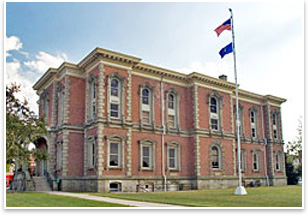
by James T. Kienle, FAIA Summary: When was the last time you saw any kind of architecture publication that did not have something on sustainability? It is difficult to be an architect today and not know about sustainability and the green building movement. Even if you do not have LEED® behind your name, you know what LEED is, and you or your clients—even some state and local governments—are demanding that your projects be LEED certified. But in our haste to make all things green, we may be losing the bigger picture. Green buildings are but part of a larger and more comprehensive landscape of conservation and sustainable development. The President’s Council on Sustainable Development set 10 goals, including health and the environment, economic prosperity, conservation of nature, and stewardship. Goal Six, “Sustainable Communities,” requires us to “encourage people to work together to create healthy communities where natural and historic resources are preserved, jobs are available, sprawl is contained, neighborhoods are secure, education is lifelong, transportation and health care are accessible, and all citizens have opportunities to improve the quality of their lives.” In our haste to make all things green, we may be losing the bigger picture Yet some architects, so proud of their LEED-certified buildings, don’t seem to think that the old building razed to make way for the new is even part of the equation. The LEED rating system certainly does not subtract points for the loss of the embodied energy in the old building or the energy expended in razing and carting it away to the landfill. Nor does it give points for salvaging “first growth” wood or masonry materials to be used elsewhere. Actually, LEED metrics don’t really account for a great deal of the green aspects found in historic buildings, making it more difficult than it should be to achieve LEED certification when renovating, restoring, or adding to a historic structure … potentially tipping the scale toward replacement due to the metrics rather than the actual sustainability.
One other word might come to mind when listening to those who envision a brave new world filled with environmentally friendly new buildings: Uh-ohThe potential results of ignoring the need to balance the new construction of green buildings with sustaining and improving the existing built environment has prompted Wayne Curtis to write in “A Cautionary Tale“ in Preservation magazine: ”One might be tempted to compare the recent green wave with the rise of Modernism more than a half-century ago. Planners and architects back then didn’t just want buildings to look different; they also wanted to change the direction society was headed. The old ways of thinking were outmoded. Yesterday’s buildings solved yesterday’s problems; new buildings were needed to solve the problems of today—and tomorrow. Of course, many people will recall what happened to America’s historic fabric the last time we undertook a nationwide revamping of the built landscape. The result was urban renewal, and it left many of our best urban areas in tatters and many of our historic buildings in piles of rubble. And though hardly anyone would argue against the need to reduce our consumption of dwindling resources, one other word might come to mind when listening to those who envision a brave new world filled with environmentally friendly new buildings: Uh-oh.” Encouraging news, but greater consideration needed It recently took a group of genteel 70-, 80- and 90-year-old women to make a “naked ladies” calendar to raise enough money and awareness to save their county courthouse There is proposed legislation before the Indiana General Assembly that would require a LEED Silver level for all new public construction and any modification to existing public structures. With the current LEED metrics giving little credit for the inherent “greenness” of historic structures and no penalties for environmental impact of discarding the old structures, one might expect some county commissioners to prefer to sell or demolish rather than refurbish existing public structures. The AIA HRC article on the meeting of preservation groups with the USGBC indicated that the outcomes of the meeting were positive, and all attending demonstrated a willingness to make substantial progress toward shared goals. This is encouraging news. But until the LEED rating system changes, the responsibility falls to our profession to take the leadership in educating our clients and the public about the inherent green nature of historic buildings.
Most buildings built before World War II have features that are inherently energy efficient and sustainable Stephen Farneth, FAIA, likewise points out in “Sustaining the Past: Guidelines for Historic Preservation Shouldn’t Have to Clash With LEED Requirements, Since Preservation and Sustainability Share Many Similar Goals,” in GreenSource magazine that “sustainability and historic preservation share many underlying values, such as an emphasis on resource conservation and energy efficiency. Most buildings built before World War II have features that are inherently energy efficient and sustainable, such as excellent cross-ventilation, operable windows, extensive use of glazing, and awnings to mitigate solar heat gain. Buildings built after World War II frequently rely heavily on mechanical systems for climate control. Many have been sited without consideration for natural lighting or ventilation and lack insulation or thermal mass. Nevertheless, while it can be difficult to balance preservation and sustainability for Modernist buildings, many are worth the extra effort.” Sustainable means old and new Architects must understand that new green buildings are but one of the factors along with historic and natural resource integration that provides the full answer to a sustainable built environment Architects are front and center in the Green Building Movement in support of sustainable communities, and therefore must understand that new green buildings are but one of the factors, along with historic and natural resource integration, that provides the full answer to a sustainable built environment. It is important to understand the full impacts of demolishing existing structures, from the embodied energy that is destroyed, to the inherent sustainability of the materials being discarded, to the many features of historic structures that are inherently green. In addition, the impacts on local culture and values should be considered, as suggested by the President’s Council on Sustainability. And it is our responsibility, if we claim to support sustainable design, to understand these issues fully while incorporating them into our practice and educating others. Ultimately, as Carl Elefante, AIA, LEED-AP, eloquently says, “We can not build our way to sustainability; we must conserve our way to it.” |
||
Copyright 2008 The American Institute of Architects. All rights reserved. Home Page |
||
What’s on your mind about the way we practice today? Send your thoughts (500-1,500 words) to Managing Editor Stephanie Stubbs and put “Think About It” in the subject line.
Find out about the AIA Historic Resources Committee.
The AIA.org podcast page has three audio offerings on historic resources (under Design and Building Performance).
The statements expressed in the article reflect the author’s own views and do not necessarily reflect the views or positions of the American Institute of Architects. Publication of this article should not be deemed or construed to constitute AIA approval, sponsorship, or endorsement.
Further reading
• “A Cautionary Tale,“ by Wayne Curtis, Preservation magazine, National Trust for Historic Preservation, Washington D.C., Jan/Feb 2008
• “The Greenest Building Is … One That Is Already Built,“ by Carl Elefante, AIA, LEED-AP, Forum journal, National Trust For Historic Preservation, Washington D.C., Summer 2007
• “Sustaining the Past: Guidelines For Historic Preservation Shouldn’t Have To Clash With LEED Requirements, Since Preservation and Sustainability Share Many Similar Goals,“ by Stephen Farneth, FAIA, GreenSource magazine, GreenSource.Construction.Com, McGraw Hill. October 2007
• “NTHP Sustainable Preservation Coalition Meeting with USGBC,” by James J. Malanaphy, AIA, Preservation Notes, the newsletter of the Historic Resources Committee, the American Institute of Architects, Washington, D.C., Summer 2007
• Sustainable America—A New Consensus, President’s Council on Sustainable Development, U.S. Government Printing Office, Washington D.C., February 1996
• “Downtown Revitalization, Sustainability, and Historic Preservation,” by Donovan D. Rypkema, National Main Streets Conference Closing Plenary Session, Washington, D.C., March 2007.

 THINK ABOUT IT: THE ARCHITECT’S VOICE
THINK ABOUT IT: THE ARCHITECT’S VOICE Are we heading toward an “uh-oh”?
Are we heading toward an “uh-oh”? Are old buildings ungreen?
Are old buildings ungreen?